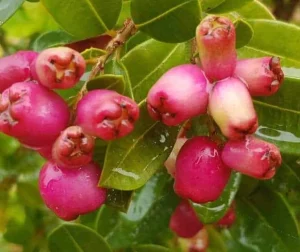Bush Cherry Fruit/Ubene Fruit
Bush cherry is botanically known as Maesobotrya Barteri or Red Maeso. A new species in the cherry fruit family. Bush cherry is still one of many people’s favorite childhood treats. It helps in hydration due to its sweet and juicy pulp.
It grows in the bush (wild), and you can grow them in your gardens too. In southeast Nigeria, it has common names in various dialects such as ubene, ubene, uvune, ufene, or uvere. As a rainforest plant, it can also be found in regions of Cote d’Ivoire and Sierra Leone. The fruit smells and tastes like wine. That is until some local wineries start using it to make wine or ubene wine as Igbo people may call it.
Looking for a new addition to your healthy diet? Look no further see their numerous health benefits and creative ways to incorporate them into your meals.
Types of bush cherries
There are several types or varieties of bush cherries, including the North Star, Meteor, and Montmorency. Each variety has its own unique flavor and characteristics, but all produce small, tart cherries that are perfect for baking, canning, or eating fresh.
Some common types of bush cherry include:
-
Prunus fruticosa
This is the most well-known species of bush cherry, and it is native to Europe and Asia. The fruit is small and round and is typically dark red or purple when ripe. It has a sweet, tangy flavor and is rich in antioxidants, vitamins, and minerals. This is the species we will be focusing on in this article.
-
Prunus japonica
This is another species of bush cherry that is native to Japan and Korea. The fruit is small and red and is often used to make cherry liqueurs and other alcoholic beverages.
-
Prunus besseyi
This species of bush cherry is native to North America and is also known as the western sand cherry. The fruit is small and red or purple and has a sweet-tart flavor. It is often used to make jams and jellies.
-
Prunus pumila
This species is native to North America and is also known as the sand cherry. The fruit is small and red or purple and has a sweet-tart flavor. It is often used to make jams and jellies. They are often used in landscaping or as ornamental plants, but their fruit can also be a healthy addition to a balanced diet.

Facts about Bush Cherry (Ubene)
The term “bush cherry” can refer to several different species of cherry trees that grow wild and may not be common like other cherries. However, I will provide some scientific facts about the most well-known bush cherry fruit:
- The bush cherry fruit is a small, round fruit that typically measures about 1cm in diameter. Bush cherry, also known as dwarf cherry or sour cherry, is a small fruit tree. It is a compact and hardy plant that can grow up to 6 feet tall and wide, making it a great choice for small gardens or container growing.
- The scientific name of the bush cherry is Prunus fruticosa, and it is a member of the Rosaceae family.
- The fruit is typically dark red or purple when ripe and has a sweet, tangy flavor.
- The fruit is high in antioxidants, especially anthocyanins, which are beneficial for heart health and can help prevent cancer.
- The bush cherry fruit is rich in vitamins A and C, as well as potassium and fiber.
- The bush cherry tree is a deciduous shrub that grows up to 2-4 meters in height and is native to parts of Europe and Asia. it is a seasonal fruit that bears fruit from April through June.
- You can use bush cherry fruit fresh or in making jams, jellies, and pies. When not fully ripe, it is sweet yet possibly acidic.
- The bush cherry fruit, in herbal medicine, is common in treating respiratory and digestive problems.
- The bush cherry tree is hardy and can tolerate a wide range of soil types and temperatures.
- The cherry fruit is a good source of energy and can be a healthy addition to a balanced diet.
- The fruit (particularly the colored variants) like other common berries turns the tongue and teeth blue.
- When unripe, it is green. Furthermore, it is ideal to let them ripen before plucking. Bush cherry does not ripen well off the tree.
- Bush cherries are smaller than other types of cherries. As a result, it draws more birds and squirrels.
- They can ripen quickly once picked from the tree. It is quite perishable, especially in hot weather.
- Bush cherries are not ideal for shipping due to their short shelf life unless they are preservatives inclusive.
It is common in both red and white varieties. However, several people have reported seeing the purple variation. From my little experience with the white and crimson red varieties, I would say the white one tastes nicer (sweeter), whereas the red one falls between sweet and sour.
Health Benefits of Bush Cherry (Ubene)
Certain people boil the leaves like vegetables, and study shows it helps to boost blood since it includes certain blood-boosting characteristics. In addition to protein, carbs, and fiber.
The root infusion in gin can aid in the treatment and management of arthritis.
When used as a chewing stick, the stem might relieve slight toothache. Increase hydration, making it a good way to keep hydrated. It contains antioxidants and vitamin C, which may aid in the following ways:
A) Reduces inflammation due to the presence of melatonin,
B) It aids in boosting the immune system,
C) Promote heart health,
D) Improves sleep quality.
E) Helps with digestion.
Uses of Bush Cherry (Ubene)
This fruit and its plants have various uses. Here are some common uses of bush cherry:
1. Culinary uses: People eat bush cherry fruit fresh or use it in the preparation of a variety of culinary dishes such as jams, jellies, pies, and liqueurs. The fruit has a sweet-tart flavor and is rich in antioxidants, vitamins, and minerals. In some countries, such as Nigeria, you can make unique wine from it. The majority of people eat it by licking it or squeezing it to make juice. Or you can use it as a topping for pastries.
2. Medicinal uses: Some traditional medicine practitioners use various parts of the bush cherry plant to treat respiratory and digestive problems.
3. Landscaping: This plant is often used in landscaping and gardening as ornamental plants. The plants have attractive flowers in spring, and the fruit can add color to the garden when it is ripe.
4. Wildlife habitat: This fruit is a valuable food source for many birds and small mammals, and the plants can provide cover and nesting sites for wildlife. The thick stem makes an excellent chewing stick.
5. Erosion control: The roots of bush cherry plants are strong and can help stabilize soil on slopes and prevent erosion especially when they are in your garden or as ornaments.
6. Conservation: Some species of bush cherry are native to specific regions and are important for conservation efforts to protect and maintain local biodiversity.
Overall, this plant and its fruit have a variety of uses and can be valuable additions to the garden or the natural landscape.

